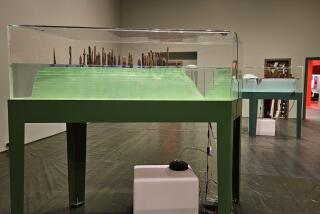‘Planet’s’ Natural Disasters Are More Sleepy Than Savage
- Share via
As natural disaster shows go, “Savage Planet” is the unplugged version. With its velvet volcanoes and somnambulated storms, this is an acoustic presentation that calls for full-blown, amped-up heavy metal. On a stage that screamed for Limp Bizkit, they booked the Backstreet Boys.
While it’s understandable that public TV wants to remain above the sideshow character of current “reality” programs, disaster is a topic that calls for at least some visual excitement. But there is precious little footage worthy of the title “Savage Planet,” which will be shown Thursdays over the next four weeks.
Instead it opts for drawn-out interviews with disaster survivors, fuzzy slow-motion reenactments of storms, floods and eruptions, and the authoritative voice of narrator Stacy Keach.
This is all very classy, but I actually fell asleep while watching what were supposed to be some of the most threatening moments ever faced by humankind. Twice.
The four-part “Savage Planet” does have its moments: the violent collapse and subsequent spewing of Mt. St. Helens as its lava flow chopped huge trees like matchsticks; hailstones the size of large golf balls pummeling Australia; the “storm of the century” in 1993.
Perhaps the most powerful story is in the tale of Lake Nyos, which sits atop a volcano in West Africa. When an underwater cliff collapses, lethal doses of carbon dioxide waft silently toward nearby villages. The result: 1,700 people die of suffocation. In scenes reminiscent of Jonestown, the viewer sees almost all the residents of one village lying dead, as their relatives relate the horror of finding them.
This is a stunning reminder of the “power of nature,” as Keach reminds us repeatedly, but it is one of the few scenarios in the series that conveys such power. For the most part the vignettes seem muted--a result of producers Beth Hoppe, Bill Jones and Liz McLeod giving too much air time to somber survivors rather than Mother Nature herself.
There are Barbara Walters-like attempts to draw tears from the interviewees. This is accomplished once, with a woman reliving a 1953 volcanic mudslide that engulfed the train she was riding in New Zealand and killed her then-19-year-old boyfriend. On another occasion, when they couldn’t get an actual survivor of the 1991 Mt. Pinatubo eruption to cry, the interpreter appeared to sob himself.
After covering Volcanic Killers, Storms of the Century and Deadly Skies, the series wraps up with Extremes, which is essentially about very high and very low temperatures. These do not lend themselves very well to visuals, as we are left to stare at mysterious “sliding rocks” that “appear to move without provocation” in Death Valley’s dry lake beds.
Keach tries to liven things up, but to little avail. At one point, he warns us that meteors are “killers from space that can put an end to all life on Earth.”
That’s when I fell asleep.
*
“Savage Planet” airs tonight at 8 on KCET.
More to Read
The complete guide to home viewing
Get Screen Gab for everything about the TV shows and streaming movies everyone’s talking about.
You may occasionally receive promotional content from the Los Angeles Times.






